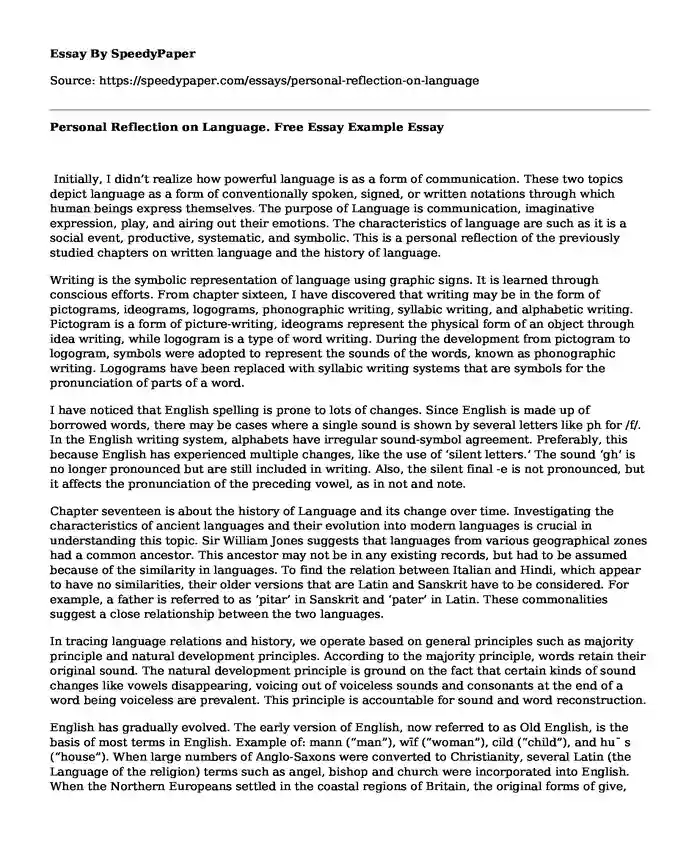
| Essay type: | Reflective essays |
| Categories: | Reflection Languages Personal experience |
| Pages: | 3 |
| Wordcount: | 673 words |
Initially, I didn’t realize how powerful language is as a form of communication. These two topics depict language as a form of conventionally spoken, signed, or written notations through which human beings express themselves. The purpose of Language is communication, imaginative expression, play, and airing out their emotions. The characteristics of language are such as it is a social event, productive, systematic, and symbolic. This is a personal reflection of the previously studied chapters on written language and the history of language.
Writing is the symbolic representation of language using graphic signs. It is learned through conscious efforts. From chapter sixteen, I have discovered that writing may be in the form of pictograms, ideograms, logograms, phonographic writing, syllabic writing, and alphabetic writing. Pictogram is a form of picture-writing, ideograms represent the physical form of an object through idea writing, while logogram is a type of word writing. During the development from pictogram to logogram, symbols were adopted to represent the sounds of the words, known as phonographic writing. Logograms have been replaced with syllabic writing systems that are symbols for the pronunciation of parts of a word.
I have noticed that English spelling is prone to lots of changes. Since English is made up of borrowed words, there may be cases where a single sound is shown by several letters like ph for /f/. In the English writing system, alphabets have irregular sound-symbol agreement. Preferably, this because English has experienced multiple changes, like the use of ‘silent letters.’ The sound ‘gh’ is no longer pronounced but are still included in writing. Also, the silent final -e is not pronounced, but it affects the pronunciation of the preceding vowel, as in not and note.
Chapter seventeen is about the history of Language and its change over time. Investigating the characteristics of ancient languages and their evolution into modern languages is crucial in understanding this topic. Sir William Jones suggests that languages from various geographical zones had a common ancestor. This ancestor may not be in any existing records, but had to be assumed because of the similarity in languages. To find the relation between Italian and Hindi, which appear to have no similarities, their older versions that are Latin and Sanskrit have to be considered. For example, a father is referred to as ‘pitar’ in Sanskrit and ‘pater’ in Latin. These commonalities suggest a close relationship between the two languages.
In tracing language relations and history, we operate based on general principles such as majority principle and natural development principles. According to the majority principle, words retain their original sound. The natural development principle is ground on the fact that certain kinds of sound changes like vowels disappearing, voicing out of voiceless sounds and consonants at the end of a word being voiceless are prevalent. This principle is accountable for sound and word reconstruction.
English has gradually evolved. The early version of English, now referred to as Old English, is the basis of most terms in English. Example of: mann (“man”), wif (“woman”), cild (“child”), and hu¯ s (“house”). When large numbers of Anglo-Saxons were converted to Christianity, several Latin (the Language of the religion) terms such as angel, bishop and church were incorporated into English. When the Northern Europeans settled in the coastal regions of Britain, the original forms of give, skin and law were adopted. The Norman-French invaded England and brought about the Language of nobility, government, and civilized life. Over time, there have been changes in epenthesis, metathesis, and prosthesis that have led to sound changes. Sematic changes such as broadening and shortening of words outline the major difference between Old English and Modern English.
As studied in the two chapters, Language has greatly evolved. Writing Language has developed from pictorial drawings to alphabetic writing. In the evolution of languages, the similarities between different languages are highlighted. Also, the effect of word borrowing because of interactions with other cultures has had a significant impact on language evolution. As various people from different cultures continue to interact, I anticipate further changes in Language.
Cite this page
Personal Reflection on Language. Free Essay Example. (2023, Aug 09). Retrieved from https://speedypaper.com/essays/personal-reflection-on-language
Request Removal
If you are the original author of this essay and no longer wish to have it published on the SpeedyPaper website, please click below to request its removal:
- Paper Example with Literature Review on Quality of Service Issues for Video Traffic
- Free Essay on the Importance of Punctuation and Grammar in Business English
- HRM Essay Example: Motivation at Work Theories Essay Samples
- HR Essay Sample: Post-Training Evaluation Plan
- Essay Example on Miscarriage
- Free Essay on The Handmaid's Tale Novel: Character of Offred
- Free Essay Sample - Health Support Mechanisms
Popular categories




